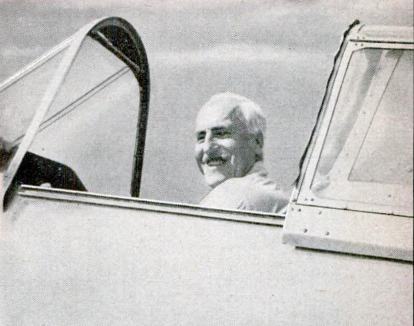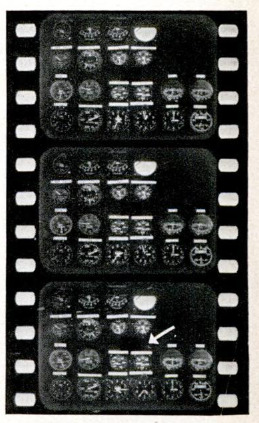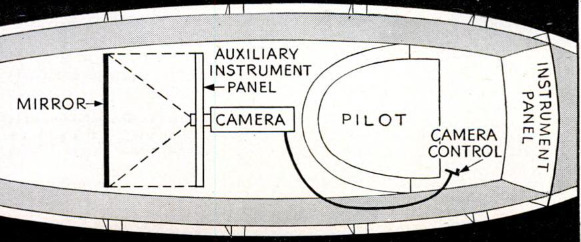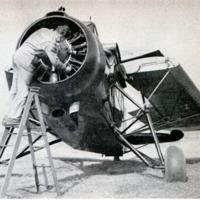-
Title (Dublin Core)
-
Flying engineer
-
Article Title and/or Image Caption (Dublin Core)
-
Title: Flying engineer
-
extracted text (Extract Text)
-
ALL THE DAREDEVILTRY and much
of the risk have been eliminated from
the profession of the test pilot. No longer
is he a nerveless young man who flies by
the seat of his pants and thinks up ingen-
ious methods of risking his life. He is an
engineer as well as a pilot, and makes a
scientific analysis of engine performance in
flight.
Today's test pilot does not start the tests
—he completes them. Before he lifts a new
plane into the air or takes off to try out a
new engine, a remarkably thorough series
of test “flights” has been performed on
drawing boards, in wind tunnels, on engine
blocks, and in pressure chambers. The pilot
is not concerned simply with finding out
whether the equipment will hold together;
his purpose is to confirm under actual flight
conditions the conclusions already reached
by technicians on the ground, or to disclose
some quirk which has remained hidden.
This change in the procedure of testing
has, of course, developed a type of pilot
different in most respects from the adven-
turous youth who formerly did the job. The
careful reading of instruments in current
tests is a far cry from the extensive use of
intuition in the old days.
Herbert V. Shebat, engineering pilot for
the Wright Aeronautical Corporation, Pat-
erson, N. J, is a personification of the con-
trast between the hit-or-miss days and the
methodical procedure of today. Now a test
pilot for one of the world's leading aircraft
engine manufacturers, Shebat studied engi-
neering at the University of Minnesota
before the World War, served with the Army
Air Corps, and was a barnstorming flyer
from 1924 to 1930, when he joined the Wright
organization. Most of his hours in the air
today are devoted to the testing of new
appliances for engines already in produc-
tion, and he has drawn on both his engi- |
neering and flying experience in putting |
Wright's Whirlwind, Cyclone, and Duplex
Cyclone engines through their paces.
‘Shebat and his coworkers at the Wright
flight-testing laboratory have thelr head- |
quarters at the Caldwell-Wright airport,
near Caldwell, N. J, about nine miles from |
the company’s plants at Paterson. Since the |
function of the laboratory is to test engines
rather than planes, the flying equipment is
curious. It includes a Douglas biplane tor-
pedo bomber built for the Navy five years
ago, a fairly modern Curtiss Hawk 75 pur-
suit borrowed from the Curtiss plant for |
confidential tests, and a ten-year-old Pil-
grim cabin monoplane. All, including the
old Pilgrim, have been flown at more than |
30,000 feet.
Shebat's job is as much varied as his
planes. Today, for instance, he may be
trying out an engine equipped with a new
device for lowering fuel consumption. Fuel |
consumption is computed in terms of pounds
a horsepower hour, and the rate of consump-
tion, guaranteed in most modern engines is
5 pound.
When the engine to be tested is installed
in one of the planes, Shebat's work com-
mences. His task is to establish a basis for
comparison with other engines of the same
horsepower, The most commonly used
standard is the propeller-load curve, com-
puted by making level test runs at specified
altitudes with the propeller in a fixed posi-
tion and with the power output varying on
each run. Then the point is found on each
run where the best performance in horse-
power and speed were produced with the
least fuel consumption.
In computing the propeller-load curve, he
is interested chiefly in the torque indicator,
the tachometer, and the fuel-flow meter.
The torque indicator registers in terms of
inch pounds or foot pounds the force utilized
in turning the propeller shaft at a given
speed. The tachometer shows the number of
revolutions a minute of the propeller, and
the two together give the horsepower at
which the engine is operating. On the in-
strument board the torque indicator is
labeled BMEP, an abbreviation for “brake
mean effective pressure,” or the pressure ex-
erted by the turning shaft on a stationary
gear connected with it by a pinion. The
pressure exerted against the stationary gear
is countered by an equal pressure created
by a pump in the engine, and thus the means
for measurement is provided.
The fuel-flow meter shows, in terms of
pounds an hour, the rate at which the fuel
is being fed into the engine. If Shebat de-
sires more precise information, he may use
the volumeter, which measures a small
quantity of fuel and feeds it to the engine
while the observer times it with a stop
watch, Work of this type has whittled the
rate of fuel consumption to a point far below
that of several years ago.
Some of the work which Shebat does
can be handled on solo flights, but other
experiments may require the assistance
of a crew of three or four. One example
is the successful attempt to reduce engine
vibration. The old Pilgrim was the guinea
pig in this series of tests, and the crew
handled the oscillographs which were con-
nected by pick-ups to various sections of
the plane. Runs were made at different al-
titudes with varying power outputs, and
the vibration was transformed through the
pick-ups into electrical impulses which
passed through a cathode-ray tube and be-
came visible on a screen. The data contrib-
uted to the development of the modern
motor mount, which cuts off from the body
of the plane the vibration of the engine.
Most of the current tests at Caldwell are
conducted at high altitudes, and, as Shebat
will tell you, high-altitude work is “some-
thing that nobody who knows anything
about it likes.” The tests are, of course,
largely confidential, but interest centers in
the development of improved superchargers.
On flights to more than 30,000 feet in an
old open Curtiss Falcon observation plane,
Shebat and his observers discovered data
valuable in developing the two-speed super-
charger, which produces moderate super-
charging in low ratio for full power at
take-off, and high supercharging in high
ratio for flying in rarefied air.
More recently, experiments have been
conducted with a multistage supercharger,
which works on a sort of tandem principle,
with one blower discharging into another.
The chief problem in developing the two-
speed type, Shebat reports, was the main-
tenance of equal pressure in and out of the
engine. It was discovered in early tests
that while pressure was maintained inside
the cylinders, the pressure outside was not
sufficient to insulate the ignition system,
and a spark would jump to a cylinder which
was not ready to fire. The problem was met
by supercharging the magneto, too.
Shebat uses a camera which photographs
the instruments during flights. In all three
planes—provision has been made for the
installation of a French-made Sept camera
which can take either motion pictures or
stills, and after each flight a permanent
record of the performance is available.
The most interesting camera arrange-
ment is that in the single-seat Hawk, where
the machine has been mounted in a spare
instrument board in the luggage compart-
ment and is operated from the
cockpit by a trigger on the
control stick. Two feet in front
of the spare instrument board
is a mirror with an aluminum
coating, and a reflection of the
instruments is photographed.
The lens is visible as a dark
spot in the center of the board.
The lighting is supplied by
two automobile headlight bulbs
of six volts, mounted above the
board out of the camera range,
and the usual shutter opening
is F/3.5. Shebat reports that
his best results so far were
obtained one day when he used
a bulb exposure without real-
izing it.
In the Douglas, more room
is available in the observer's
cockpit, and the camera is
mounted four feet from the
spare instrument board. To
Keep the two in the correct
position in relation to each
other, they are connected by
metal rods which transmit the
vibration from the board to the
camera. The lighting arrange-
ment is the same as that in the
Hawk. At high altitudes, the
low temperature interfered with
the mechanism of the camera
until an electric heating pad
was wrapped around it.
Shebat’s work is by no means
without risks. Engine failures
have been numerous, but he
has always been able to land
the plane safely. On one flight
near Caldwell, the propeller
and reduction gear dropped off,
but since the airport was only
four miles away and the plane
was 6,000 feet up, he landed.
The lost parts dropped a few
feet from a woman in her gar-
den. She was angry, not be-
cause she had nearly been
killed, but because she was
covered with dirt when the
neighbors came running up.
-
Language (Dublin Core)
-
Eng
-
Date Issued (Dublin Core)
-
1941-04
-
pages (Bibliographic Ontology)
-
49-51
-
Rights (Dublin Core)
-
Public domain
-
Archived by (Dublin Core)
-
Sami Akbiyik
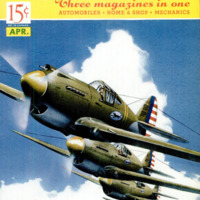 Popular Science Monthly, v. 138, n. 4, 1941
Popular Science Monthly, v. 138, n. 4, 1941

